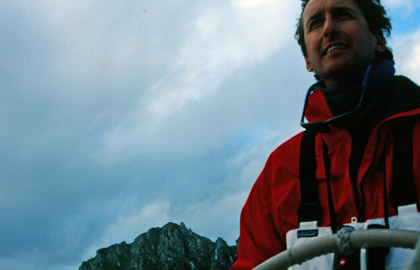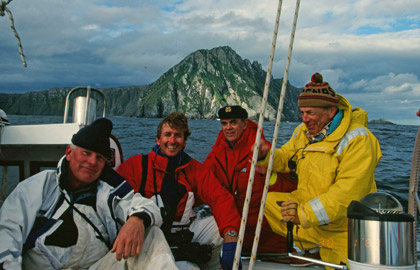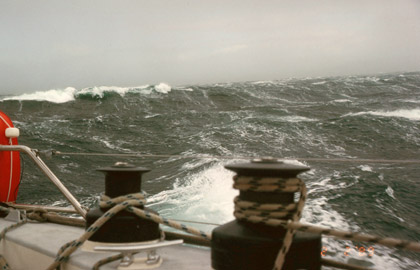AGAMEMNON FILMS



There is something magnificent about Cape Horn. It is a place of elemental power, of primordial energy; wind, sea, rock, ice, rain, sun. All in perpetual motion and conflict, and also in perfect balance. To navigate a small craft around the Cape and through the islands of the archipelago immediately to the north of it is one of the most challenging and exciting experiences a yachtsman can ask for. Cape Horn. Cabo de Hornos. Cape Stiff. The name resonates with legend.
A year ago my friend and colleague Billy Graham (the film director, not the evangelist) phoned with a mad idea: Billy and film producer Roger Gimbel had formed a society for the stated purpose of sailing around Cape Horn. It would be called, for some reason, Sociedad de Cabo de Hornos. There were two founding members: Roger and Billy -- a couple of very salty and experienced sailors. I thought it was the finest idea I had ever heard of and instantly became a third member. Yacht broker Carlos Echeverria (those who have studied the Mexican revolution will remember his grandmother) was the fourth.
We researched and planned and bought Sailing Directions, books, and the entire Patagonia catalog. For a year we schemed, and Carlos found us the perfect vessel. The steel-hulled sloop Pelagic would be available for a one-time charter in the Tierra del Fuego/Cape Horn area in January/February of '89. Her co-owner, Skip Novak, had just handed her over to partner Phil Wade in South Africa after an expedition to the Antarctic (see YACHTING, Jan.'89).
Pelagic had been hatched from the dreams of Phil and Skip while they were bashing their way around the world in the last Whitbread Race on Drum. An ideal boat for the Southern Ocean, Pelagic was carefully designed by Patrick Banfield with a heavy lifting keel for shoal waters and ice; simple ultra-strong sloop rig; fuji-battened main; clean, flush decks with a small permanent deckhouse over the hatchway; and a double main hatch. We agreed to leave from Ushuaia and our route would be determined by the weather and the vagaries of the Chilean Navy, which (owing to the on-going cold war with Argentina) controls the movements of all maritime traffic in these waters.
Phil Wade and first mate Yosie Katalan met us at the Albatross Hotel in Ushuaia. You can tell that these men are serious bluewater sailors as soon as they walk in the room. Their hands are thick and every finger a marlin-spike, their oceanic tans deep and their manners quiet, confident, full of wit and grace. Phil has sailed more than three hundred thousand miles (this figure staggers me). Yosie, a submariner in the Israeli Navy, had taken a holiday from his job as captain of a 75' sailing yacht in Turkey. I wondered if these guys ever did anything mundane, like golf or tennis, on their day off. Probably not.
With this ship's company, we cast off our mooring lines at Ushuaia and weighed our anchors and set sail for Cape Horn. Phil's standard anchoring system uses two, 100-meter warps, shackled to wire strops on bollards ashore and three anchors: a big CQR shackled in line with a bigger Danforth on 100 meters of one-inch hawser. It took about an hour for us green hands to get all this gear stowed and something less to rig it each night but it served us well. We had all read the stories by Slocum, Roth, Bjelke, et al, of getting blown out of anchorages.
(L-R) Billy Graham, Fraser Heston, Carlos Echeverria and Roger Gimbel

Our first port of call was Puerto Williams, Chile, about 25 miles down the Beagle Channel. We had 30 knots of westerly to push us down there under full sail and pleasant sunny skies. This amount of wind proved to be about the average, though on occasion we would have plenty more. The Beagle Channel cuts through the tip of South America on an east-west line, cutting the main island of Tierra del Fuego off from the smaller group of islands. It is one of the most spectacular stretches of water in the world. Great jagged peaks rise right up out of the slate-gray sea on either side of the fjord, serious dark pinnacles of black rock stark against the white of permanent snowfields. The highest peaks are 8,000 feet above the sea; lenticular clouds were flying like banners off these, testament to the howling winds that perpetually blow at that altitude, stratospheric gales which, occasionally, stoop to touch the sea.
Puerto Williams is a checkpoint for Customs and Immigration and a Chilean naval base, although aside from a few gunboats and an old World War II frigate sunk at her moorings you would hardly know it. Pastel-colored houses straggle up from the shore toward the dark, timbered flank of the mountains of Isla Navarino.
Naval responsibilities are taken very seriously here in Chile and they are twofold: the security of the country and the security of the yachtsmen who are welcome to sail here. Yachts are required to report in daily to various control points in the islands and also whenever they pass any port. Certain bodies of water are prohibited, such as Canal Cockburn and Murray Channel, as is anchoring in certain coves. Commandant of the port, Teijente Jordan explained to me that they are genuinely concerned for the safety of the yachts that cruise Chile's treacherous waters. "Last year there were more than 80 yachts... even un loco windsurfer!" Given the truly awful weather the region is famous for, it is amazing that they let anybody down there at all. As it is, you must pass inspecion before you are given el permiso for the Cape.
Our departure from Puerto Williams was delayed by the arrival of Howard Rice, the first American to kayak around the Horn alone, who came cheerfully paddling over to us for breakfast. He had been battered by 90-knot winds and huge waves, had capsized off Wollaston Island and crashed on a rocky beach.
We left later that afternoon and motored down the eastern edge of Isla Navarino toward Caleta Yawl in a flat calm and a cold rain. The temperature was usually cool, averaging in the low forties and fifties during the day. We were well prepared with synthetic long underwear, layers of pile pants and synchilla sweaters, wet-suit gloves, ski goggles, seaboots and heavy-duty foul weather gear. During the cruise we wore various combinations of the basic trousseau but most of the time when we were on deck we shamelessly donned the whole shooting match. After a day or so, we got used to dressing like polar explorers and perhaps we also got used to the cold. In any event, it never dampened our enjoyment.
Since it was calm, we were able to observe an amazing variety of birds and mammals in the eastern end of the Beagle Channel: Blackbrowed albatross soared effortlessly, gliding on the face of the waves, then turning and wheeling up into the steely sky. Brown skuas and black and white cormorants dove, squawking, into the sea. Small, timid Magellan penguins ducked under the water at our approach and swam off, appalled. Antarctic terns spun overhead. A big bull fur seal bellowed on a rock in mid-channel. Phil served an elegant lunch below, replete with salad, cheeses, sausages, chilled South African wine and a rich heady brew he optimistically termed "goose soup."
The day we rounded Cape Horn dawned crystal clear, calm and cold. We motored through Paso Goree, past Isla Picton and into the infamous Bahia Nassau in warming sunshine. If you stayed out of the wind you could sunbathe with your shirt off. We had been warned about Bahia Nassau, but it was smooth and glassy, with only a hint of ominous rolling swell coming off the Southern Ocean to remind us where we were.

Having heard all the stories of the most fearsome cape in the world and read all the books about the ghosts of Cape Horn we were so full of Cape Horn legend that I, for one, simply did not know what to expect. I remembered Sir Francis Chichester's quote from Gypsy Moth Circles the Horn: "The seas around Cape Horn had a reputation unique among all oceans of the world . . . . Off the Horn there are gales Force 8 or more one day in four in spring, and one day in eight in summer . . . the waves are likely to be 60 feet high."
What we did not expect was flat calm. As the day went on in eerie calm, we all became apprehensive that either we were in for an almighty blow or, ignominy of ignominies, the Sociedad de Cabo de Hornos would have to motor around Cape Stiff. Fortunately, we were spared this disgrace. A brisk 25-knot westerly sprang up as we sailed into the desolate Wollaston group, through Paso Bravo, past the tall mossy pinnacles looming over the channels, barren and windswept and devoid of any vegetation higher than a shrub. We hoisted all plain sail and sailed close-hauled out between Isla Herschel and Isla Deceit and there, fine on the starboard bow, lay Cape Horn.
My heart began to pound with excitement as the castellated pinnacles of that mysterious island came into view. It looked like an island out of a fantasy, something painted by Frazetta. It was astounding. I had read some disgruntled accounts by mariners who sailed past this fabled cape well out to sea, who were disappointed by the appearance of the actual item. Well, either they were too far off or they had hearts of stone. Nothing I had read could have prepared me for the grandeur of it, both in myth and reality.
Great winged albatross flew wheeling over the rocks and booming surf, screaming and crying out in the wind, turning and soaring past us in exaltation, fully at home and happy in this awesome place. We tacked along the southern flank of the island, closing within a hundred yards or so of the rocks, and then sailed easily past the looming bulk of the Cape itself, which towered darkly above the bright heaving sea, the official end of the earth.
Roger stood on the foredeck and whooped ecstatically. Phil popped the champagne. We cheered and drank in the cold heady wine, taking turns at the helm as we beat our way around the Horn.
As we rounded the windward shore, sailing between dragon's teeth rocks breaking with surf, a black squall began to fill the northwestern horizon. We anchored in a little no-name bight on the eastern side, in blinding rain and 35 knots of wind. As we sipped single-malt whisky and glacier ice that Phil had picked up at the far end of the Beagle Channel, a gigantic, complete double rainbow appeared to leeward. Snug in the heated cabin below we tucked in to a feast of risotto parmesan (prepared by guest-chef Billy), Phil's Fish Pie and a rich, red Argentinean wine. Roger strung his bipole antenna to the spreaders. "This is KB6AVR, KB6AVR... C-Q, C-Q," he intoned into the crackling ether, then proudly, "KB6AVR, Cape Horn, Chile!." and was pleased to contact a ham in Los Angeles who kindly patched him in to his young son, Barney.
The next morning we shifted anchorages and took the Zodiac ashore on Isla Hornos. We were met by two of the lightkeepers, who seemed glad to see us. We had coffee and freshly baked biscuits with the lightkeepers and gave these friendly fellows a bottle of wine, a New York Yacht Club burgee and a Sociedad polo shirt. After lunch we signed their log and they stamped ours with the postal stamp. They took us on a tour through the swampy wilds of the island, inhabited largely by tuxedo-clad penguins.

That afternoon we had a long fast reach in boisterous winds back to Wollaston and a long beat up to and through Bravo Channel. We sailed into the long deep inlet called Bahia Scourfield, which is entirely surrounded by great green peaks and looks more like Bora Bora than Cape Horn. We hiked up through the dinosaur land in wind and sun and rain and hail, climbing past a waterfall to a fantastic lake at the head of the valley. At the lake we all lay exhausted on the spongy ground and watched the williwaws blast the surface of the water into white foam. One bowled me over, then gusted down the valley to knock Pelagic over 10-15 degrees and continued on to Antarctica. I had no idea how strong these winds were.
Over the next few days we beat our way westward up the Beagle Channel against the howling prevailing wind to see the glaciers at the western end. We stood short watches and I had a wild stint at the helm, steering under quadruple-reefed main and storm jib and, later, just jib. The anemometer was touching fifty. At the time, I saw an albatross soaring along the top of a wave, perfectly at ease with the elements, at home in the gale. It occurred to me that this creature was devised to be at one with wind and sea, made expressly to thrive in conditions that man finds, at the least, somewhat appalling. The albatross soars effortlessly over waves that sweep our decks, the perfect synergism of design and environment, to which, as sailors, we can only aspire.
Fifty-five miles (and almost as many tacks) from Puerto Williams, we pulled into Caleta Olla, a snug cove at the foot of Hollandia glacier. Phil led us on another of "Phil Wade's Tierra del Fuego Survival Hikes" to the lake at the foot of the glacier - what became an overland, hell-in-the-swamp epic. But that night we were rewarded with a barbecue on the beach: freshly gathered mussels steamed over the fire in their own shells with butter and garlic sauce, an entire sheep that Phil had thoughtfully stowed in his deep freeze, and a huge jug of Chilean rotgut wine.
The glaciers slid past us, more spectacular and more frequent the farther west we sailed up the Brazo Noroeste, the northeast arm of the Beagle Channel. They all had international names: Espania, Francia, Hollandia, Romanch, Italia. Big unnamed and unclimbed peaks loomed up higher and higher on either side, plastered with snow. We shoved off Romanch, the most spectacular so far in front of an astounding river of blue-green ice, which tumbled chaotically out of the sky and down the slick rock face.
That night we anchored snug with lines ashore in Seno Garibaldi, a huge fjord with a startling gigantic glacier at its head. It revealed itself before us in the last fading pink alpenglow filling up the entire sky with its big imposing peaks and guarded flanks, cloud banners streaming off its summit. In the morning, the entire sound was choked with ice, the wind having changed direction.
Pelagic's steel hull broke through the pack ice and we motored on, stopping to photograph a sea lion rookery where four or five big slug-like bulls roared dominance over their harems of 30 or 40 females and little wet black nursing pups - all barking and honking away happily and making a terrific stench. Three separate glaciers joined here, calving icebergs into the bay with a booming resonance every ten minutes or so and sending a low swell across the sound. Pelagic made her way dead slow through the bergy bits right up to the blue face of the biggest glacier, nudging flows out of the way with her resounding steel hull.

That night I fell asleep to the sound of my old friend the wind rising in the rigging, and woke to the sound of icebergs grating softly against the hull.
On the way back to Ushuaia we were rewarded with more glaciers, more mussels (steamed and eaten in the sunny cockpit and washed down with cold white wine and Mozart on the deck speaker). We found another beautiful anchorage (Awaikhirr, one of the forbidden coves, but we were kindly given permission to spend the night there) and had a speedy spinnaker run down the Beagle Channel to Puerto Williams, where we had to clear customs for Argentina.
The last trick at the helm fell to me. We were beating against the westerly gale, making the final leg up the channel toward Ushuaia. The wind freshened and backed northerly, which allowed us to scrape by the rocks at the entrance to Ushuaia Bay. We slanted in on a long board, Pelagic blasting along close-hauled in 45 knots of wind and spray with two reefs in the main and the full staysail stiff, stable and fast, like the albatross, at home in her element.
I have never been so happy reveling in the pure joy of sail. It was a proper end to the first Sociedad de Cabo de Hornos cruise.